Costa Rica's rainforest reborn by butterflies
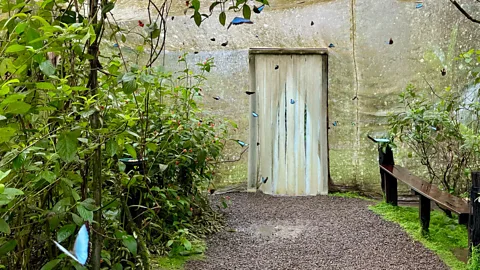 Mizuki Uchiyama
Mizuki UchiyamaIn a remote corner of Costa Rica, a former cattle pasture has been restored as a lush rainforest, thanks to one family and thousands of butterflies.
The road north from San José winds through fern-studded hills before dissolving into mist. The villages become smaller, the air grows heavier and the tarmac narrows until the rainforest swallows the road. When the bus doors swing open, I find myself surrounded by green.
I walk towards a wooden gate marked Pierella Ecological Garden and pause. Tucked away in the town of Sarapiquí, Costa Rica, this private rainforest reserve isn't mentioned in many guidebooks, but it's home to one of Costa Rica's most unforgettable experiences.
Once a barren cattle pasture, this small family-run lodge is now surrounded by a regenerated rainforest. Pierella's owners, William Camacho and Kristal Barrantes, have spent the last three decades planting native trees and plants – and it is one of the few places in the world practicing butterfly-led rewilding. Dozens of butterfly species are raised and released here, helping to pollinate plants, disperse seeds and kick-start the complex dynamics a healthy forest needs. As the vegetation has slowly returned, so too have the birds, frogs, reptiles, monkeys and ocelots that now move through the forest.
 Mizuki Uchiyama
Mizuki UchiyamaIn a country full of luxury eco-lodges, this off-the-beaten-path destination feels different. Guests stay and eat with the family, and the experience is deeply personal. It's rewilding with a human touch – an example of how tourism, when rooted in reciprocity, can help nature heal.
At the gate, I am invited in by a chorus of bird calls coming from the red ginger plants and cecropia trees. I walk a few steps along a path leading into an open-air kitchen and dining area where Kristal Barrantes, who manages the property, smiles and offers me a homemade dessert.
After finishing it, Gerald Barrantes (Kristal's nephew), lifts a spotting scope used for birdwatching and grins.
"Ready for an adventure?"
Under the dense, green canopy, Gerald whispers, "Come look at this." I lean in over a broad leaf where a red-eyed tree frog blinks back at us – lime-green skin, crimson eyes, blue-striped legs and tiny orange toes that seem to glow. Just beyond, a toucan with a yellow throat and a reddish band across its chest tears into a banana with its long, two-toned beak.
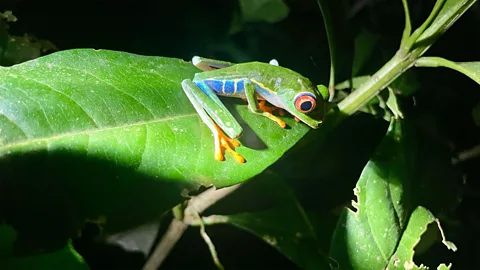 Mizuki Uchiyama
Mizuki Uchiyama"Now look through the spotting scope," Gerald says, adjusting the tripod. Through the lens, I spot a majestic turkey vulture, its small red head vivid against the pale blue sky. Gerald explains that these birds live far from human settlements, deep in the wild. High in the trees, a sloth naps lazily, its brown fur blending perfectly with the branches.
Gerald keeps pointing out new creatures, one after another. He explains that in total, more than 200 bird species live in this four-hectare forest, along with monkeys, sloths, iguanas, bats, ocelots and countless frogs and insects. Cacao grows along the paths as well, and visitors can join a hands-on chocolate workshop.
It's hard to believe that this thriving rainforest was once a sun-bleached field.
"In 1995, Pierella was nothing but grassland – just cows and fences," says Gerald, as we hike through the property's narrow dirt trails.
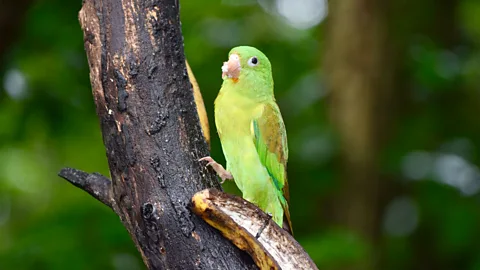 Mizuki Uchiyama
Mizuki UchiyamaCamacho wanted to restore what had once been rainforest. He had always loved butterflies and saw them as a way to bring life back to the land. Using his savings, he bought a 20m x 20m plot of pasture, planted host trees for butterflies and created a small, sustainable butterfly farm in partnerships with the Costa Rican Entomological Supply, selling chrysalises to butterfly houses and zoos around the world.
Over the past 30 years, he has steadily reinvested the income from his butterflies to purchase neighbouring farmland, transforming the once-barren grazing area into the lush rainforest that stands today.
Camacho became one of the first butterfly breeders in Costa Rica to adopt sustainable methods, and farmers across the nation who once cleared trees now visit the property to learn how eco-tourism can replace livestock income.
Gerald soon leads me towards a mesh-covered area. Inside the butterfly tent, called the Butterfly Garden, hundreds of butterflies in a kaleidoscope of colours flutter around me – so many it feels as if I've stepped into a different world.
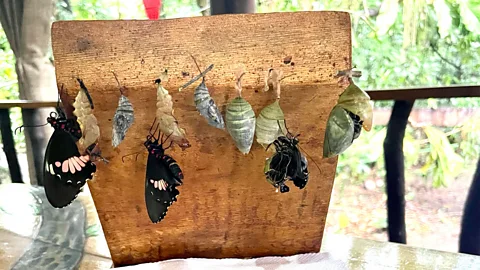 Mizuki Uchiyama
Mizuki Uchiyama"We planted for butterflies – the birds did the rest," Camacho says to me, as the insects fly around him. "The butterflies attracted birds; the birds dropped seeds; and the seeds became forest," he says.
Costa Rica has quietly become the world's leading exporter of live butterflies, shipping nearly half a million pupae each year to exhibitions around the globe.
More like this:
• The stunning Canadian island you can see but not touch
• A desert-to-sea adventure on Australia's 'other' reef
• The remote isle where pygmy hippos roam
Camacho explained that at Pierella, butterflies sit at the heart of the restoration process. As they feed and lay eggs, they pollinate plants and draw insect-eating birds and reptiles into regenerating areas. Their presence helps rebuild the food web from the bottom up – creating the conditions that allow frogs, bats, snakes and small mammals to return.
At an open-air lab, Gerald stands by a blackboard, explaining how Costa Rica's total forest cover fell from 75% in 1940 to just 21% by 1987. Thanks to nationwide reforestation and eco-tourism efforts, he says the nation's forests have since rebounded to roughly 60%. Behind him, rows of chrysalides gleam like polished jade. Gerald lifts one delicately, showing how different caterpillars harden and shift colour. I witness the moment a caterpillar begins to turn green from the centre of its head, hardening into a chrysalis – a silent metamorphosis taking place before my eyes.
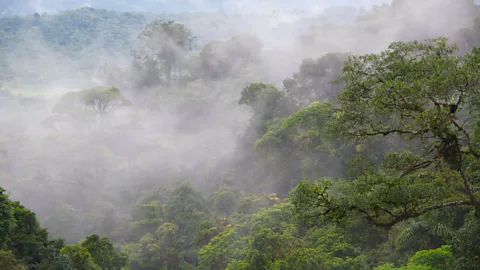 Alamy
AlamySince 1995, Camacho and Kristal have led educational tours to thousands of eco-tourists and students from all over the world. Tourist revenue sustains both the family and the land, funding further reforestation and community education.
Plan your trip
When to go: Rain falls year-round, but the driest months (Dec-Apr) make the trails easiest to walk. Apr-Aug is peak season for white-collared manakin courtship.
Getting there: Buses run from San José to Horquetas de Sarapiquí (approx 2 hours). Ask to stop at Cuatro Esquinas de Horquetas then follow signs to Pierella (10 minutes on foot). Message ahead on WhatsApp (+506 8309 0190).
Stay: Cabins sleep two to five guests and include private bathrooms. A night's stay (US$100/£76) includes guided day and night tours, homemade meals and a hands-on chocolate workshop.
Visit: Day visitors can join the rainforest tour (US$30/£23), which typically last 1.5-2.5 hours. Afterwards, stay for a home-cooked Costa Rican lunch (US$15/£11).
When the sun sets, I walk to the dining area, where a home-cooked meal of casado (the country's quintessential plate of rice, beans, salad, fried plantains and chicken), and olla de carne (a rich beef stew simmered with root vegetables, carrots and plantains) is waiting for me. All are cooked over a wood fire, filling the air with the comforting scent of smoke and spice.
As darkness falls, Gerald reappears with headlamps. "Let's explore the night rainforest."
The forest transforms at after dark. Sound replaces sight – frogs trill, wings brush against leaves and a faint patter of rain falls through the canopy. Flashlights reveal leaf-cutting ants marching in long lines holding green blades above their heads, strawberry poison dart frogs, a coiled snake and a green basilisk.
As we move farther along the trail, Gerald pauses beside a broad heliconia leaf. "Look from below," he says. I crouch down and peer inside. A family of Honduran white bats cluster beneath the leaf, their white fur shining in the beam. I didn't know that white bats even existed and I'm utterly thrilled.
 Mizuki Uchiyama
Mizuki UchiyamaBack at the lodge, I'm equally enchanted by my room. The spacious cabins' wooden rooms are surrounded by forest. It feels like living inside the jungle itself.
In the early morning, the low call of monkeys somewhere beyond the trees wakes me. For a moment, I just listen to birds calling, insects buzzing, unseen creatures stirring the leaves. I make my way to the dining area, where white-necked Jacobin hummingbirds sip from feeders. Nearby, dazzling green honeycreepers dart between branches. Shining honeycreepers, their bodies a vivid cobalt blue striped with black, flash through the trees.
Around them, countless other brilliantly coloured birds I've never seen before gather to feast on ripe bananas. I sip a cup of freshly brewed coffee, listening to the layered morning chorus.
As I eat breakfast, Gerald places a chrysalis on the table beside me. "It's about to hatch." Within minutes, the shell quivers and splits. A damp butterfly slides out, trembling, its wings soft as silk.
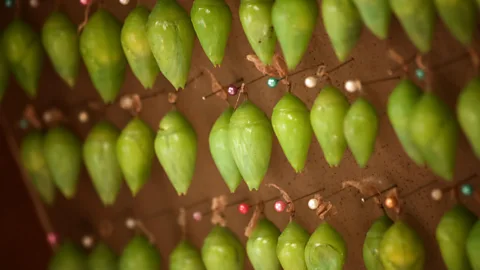 Alamy
AlamyBack inside the Butterfly Garden, a newly emerged blue morpho slowly unfolds its luminous wings, then lifts toward the canopy – a flash of colour disappearing into green.
It's hard to believe this entire world began with a single idea: that planting for butterflies could one day bring back the jungle. A small act that has sparked big consequences – a true butterfly effect.
--
If you liked this story, sign up for The Essential List newsletter – a handpicked selection of features, videos and can't-miss news, delivered to your inbox twice a week.
For more Travel stories from the BBC, follow us on Facebook and Instagram.
